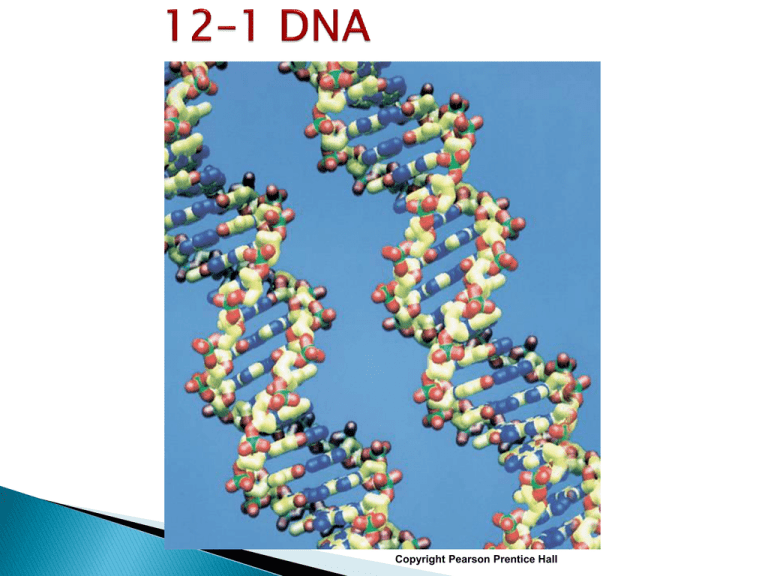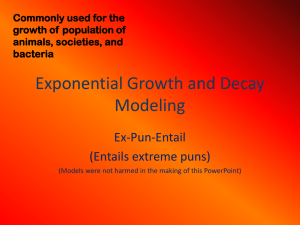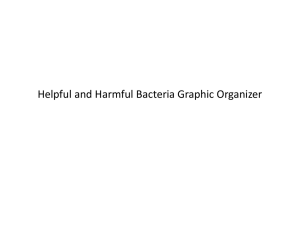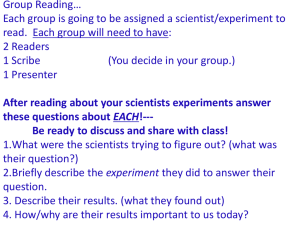
Copyright Pearson Prentice Hall
Griffith and Transformation
1928, British scientist Fredrick Griffith was
trying to learn how certain types of bacteria
caused pneumonia.
Isolated two different strains of pneumonia
bacteria and grew them in his lab.
Griffith made two observations:
(1) The disease-causing strain of bacteria
grew into smooth colonies on culture plates.
(2) The harmless strain grew into colonies
with rough edges.
Griffith's Experiments
Griffith set up 4
individual experiments.
Exp. 1: Mice injected
with the disease-causing
strain, developed
pneumonia, and died.
Copyright Pearson Prentice Hall
Exp 2: Mice injected
with the harmless strain
of bacteria. These mice
didn’t get sick.
Harmless bacteria
(rough colonies)
Lives
Copyright Pearson Prentice Hall
Exp 3: Griffith heated
the disease-causing
bacteria & injected the
heat-killed bacteria into
the mice. The mice
survived.
Heat-killed diseasecausing bacteria (smooth
colonies)
Lives
Copyright Pearson Prentice Hall
Heat-killed diseasecausing bacteria
(smooth colonies)
Exp 4: Griffith mixed his
heat-killed, diseasecausing bacteria with live,
harmless bacteria &
injected the mixture into
the mice. The mice
developed pneumonia
and died.
Harmless bacteria
(rough colonies)
Live diseasecausing bacteria
(smooth colonies)
Dies of pneumonia
Copyright Pearson Prentice Hall
Heat-killed diseasecausing bacteria
(smooth colonies)
Griffith concluded that the
heat-killed bacteria
passed their diseasecausing ability to the
harmless strain.
Harmless bacteria
(rough colonies)
Live diseasecausing bacteria
(smooth colonies)
Dies of pneumonia
Copyright Pearson Prentice Hall
Transformation
Griffith called this process transformation because one
strain of bacteria (the harmless strain) had changed
permanently into another (the disease-causing strain).
Griffith hypothesized that a factor must contain
information that could change harmless bacteria into
disease-causing ones.
Avery and DNA
Oswald Avery repeated Griffith’s work to determine
which molecule was most important for
transformation.
Avery and his colleagues made an extract from the
heat-killed bacteria that they treated with enzymes.
Copyright Pearson Prentice Hall
The enzymes destroyed proteins, lipids,
carbohydrates, and other molecules, including
the nucleic acid RNA.
•
But………Transformation still occurred.
Avery
and other scientists repeated the
experiment using enzymes that would break
down DNA.
When DNA was destroyed, transformation did
not occur. Therefore, they concluded that DNA
was the transforming factor.
Copyright Pearson Prentice Hall
Avery and other scientists discovered that the
nucleic acid DNA stores and transmits the genetic
information from one generation of an organism to
the next.
Copyright Pearson Prentice Hall
The Hershey-Chase Experiment
Alfred Hershey and Martha Chase studied viruses —
nonliving particles smaller than a cell that can infect
living organisms.
Copyright Pearson Prentice Hall
Bacteriophages
A virus that infects bacteria is known as a bacteriophage.
Bacteriophages are composed of a DNA or RNA core and
a protein coat.
Copyright Pearson Prentice Hall
They grew viruses in cultures containing radioactive
isotopes of phosphorus-32 (32P) and sulfur-35 (35S).
If 35S was found in the bacteria, it would mean
that the viruses’ protein had been injected into
the bacteria.
Bacteriophage with
suffur-35 in protein coat
Phage infects
bacterium
No radioactivity
inside bacterium
If 32P was found in the bacteria, then it was
the DNA that had been injected.
Bacteriophage with
phosphorus-32 in DNA
Phage infects
bacterium
Radioactivity
inside bacterium
Nearly all the radioactivity in the bacteria was
from phosphorus (32P).
Hershey and Chase concluded that the genetic
material of the bacteriophage was DNA, not protein.










